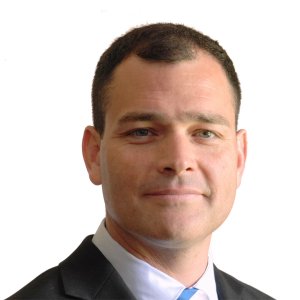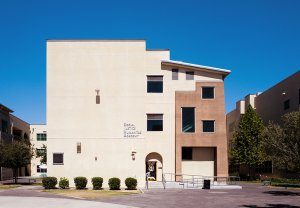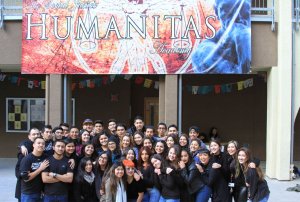‘The Anger Pushed Me Through’: On Founding a School
Jose Luis Navarro, a principal and former California Teacher of the Year, shares his struggles and successes working with disadvantaged students in Los Angeles.

By middle school, Jose Luis Navarro was skipping class, getting into fights, and using drugs. But a teacher helped change the course of his life.
“I was taken aback by the power of a single teacher,” said Navarro. “I realized a teacher could stand between me and my bad decisions.” That insight would later serve as inspiration for his career. Navarro went on to college, where he worked part-time as a firefighter to help pay tuition. After half his crew was killed in a deadly blaze, he “came to see life as a gift,” and decided to become an educator, eventually taking a position as a history teacher at a Title I high school in his hometown.
His early days in the classroom were rocky—he didn’t know how to take attendance or plan a lesson—but he stuck with it. A decade later, Navarro and a few like-minded colleagues applied to run their own pilot school. In 2011, the Social Justice Humanitas Academy opened with Navarro as principal. Navarro has focused intently on helping his 506 students—almost all of whom are low-income and Latino—overcome obstacles and succeed.
Navarro is National Board Certified and was named California Teacher of the Year in 2009 and Los Angeles Times Latino Educator of the Year in 2013. Edutopia sat down with Navarro to talk about his early life, the start of his teaching career, and why he thinks he's been so effective at reaching disadvantaged students.
EDUTOPIA: What did you think of school when you were growing up?
JOSE LUIS NAVARRO: I grew up pretty poor, and school was just one of those things I had to survive. In Los Angeles, there are a lot of gangs and a lot of violence issues. It was very common for fights to break out on my way home from school. Older kids would chase me. I started hanging around the gangs, and I got wrapped up in them and in drug use by middle school.
I was more than happy to be the smart kid that was hiding in the shadows and failing quietly.
What was odd was that I had the cognitive capability to succeed in school, I just didn’t have any of the skills. School was always very confusing to me. My dad left when I was 2, and I was raised by a single mom who suffered from depression. She was never really there to help my brother and I. I don’t remember hating any of my teachers. I think I had a pretty good relationship with most of them. I remember most of them saying they were disappointed in me because I wasn’t living up to my potential. I had test scores that were off the charts, but I couldn’t really spell. I really couldn’t read very well, but my problem-solving capabilities were strong, according to them. I heard that a lot.
I would have loved to have a mentor—somebody older than me who tried to show me the ropes—because I was more than happy to be the smart kid that was hiding in the shadows and failing quietly. In ninth grade, I had a very influential teacher. That’s when things really started to shift for me.

EDUTOPIA: What other experiences in your life—either in school or during your early years as a teacher—have influenced the culture you’re building at your school now?
NAVARRO: One thing that was influential happened when I first started teaching. Three weeks into the year, I gave a geography quiz in my history class. Without exaggeration, less than 30 percent of my kids could find Mexico on the map. Ninety-five percent of my students were Latino—the majority were Mexicans—and they couldn’t find Mexico on a map! I went to one of my master teachers, somebody the principal suggested. I told him, “Yeah, you know, I gave this quiz,” and I heard two things. One: “Oh, no, no. Don’t give them quizzes. They’re just going to let you down. They’re just going to fail.” I thought that was strange, and I heard that numerous times. And the second thing he said really shook me, and it made me angry—probably how a lot of students feel. He said, “Jose, you can’t make chicken salad out of chicken sh--.”
I realized my kids were fighting an uphill battle. Help wasn’t going to come from the outside, and I still believe that today. It had to come from me, my staff, these students.
I think a lot of people might have thought that they were off the hook then. And I didn’t. I was insulted because I was one of those kids—poor, minority, with a single mom. I just needed somebody to have the will to stand in my way, the will to teach me. It wasn’t the skill. I obviously didn’t have the skill—I didn’t take an education class until I got my master’s degree. But I had the will to do it, and so I decided to learn how to teach. So many adults around me simply didn’t have the will and didn’t care about the students. I realized my kids were fighting an uphill battle. Help wasn’t going to come from the outside, and I still believe that today. It had to come from me, my staff, these students. And I learned that three weeks into my first year of teaching. On the other side of it, there were a lot of teachers who simply didn’t know what to do, but had the will and deeply cared about the students and the school. I found teachers like that, and eventually, we started a school.
EDUTOPIA: Why do you think you’ve been so effective at reaching disadvantaged students?
NAVARRO: We started the Humanitas program [the precursor to the school Navarro started] with a bunch of teachers working together, trying to maximize their influence in the one arena that they have the most influence: their classrooms. We made a really great interdisciplinary, humanities-based curriculum. We put a lot of time into creating assessments after the district gave us a blank check to do our own. So we had great curriculum and we had great assessments, and what we found was that kids still failed. I was like, “How the hell can this be? I’m National Board Certified. My partner’s National Board Certified. I’m the California Teacher of the Year. How is it that my kids are still failing? I’m the best there is on paper.”
I realized it wasn’t enough. We realized we needed to build a community around these kids, and I think that’s really why we have been successful. We needed to use students’ mistakes to teach them, just like us. When a kid makes a mistake, schools often pound them, suspend them, kick them out. It’s like, simply talk to them and ask, “If you could do this again differently, would you?” “Yeah, totally. That was a bonehead mistake.” “If it happens again, it’s not a mistake, it’s a habit, and then I’m going to deal with you differently.”
It’s amazing the response and the respect you get when you treat someone with some respect. The adoption thing is also a big deal. We know all of our kids individually. We put a lot of time into building relationships. When we started six years ago, one of the schools next door called it a bunch of “huggy, touchy stuff.” We’re the huggy, touchy, hippie school just because I shake all my kids’ hands. I give them a hug. I know what’s going on in their lives. I ask them questions. And when a kid makes a mistake, I don’t just throw the book at them. They’re people. They’re not failing—they’re learning. Treating teachers with respect and giving them the time to do their work is important too. All my teachers have multiple conference periods so they can get as much of the work done at work while the kids are still in the building.

EDUTOPIA: How do you ensure you’re staying on track?
NAVARRO: One thing is we look at data a little differently. I love data; I think it’s sexy. Data’s always been seen as punitive, so schools don’t want to look at it. I always want it and am always trying to look at it with a human lens. So why is this student failing? Well, let’s look at the data—the attendance, the test scores, their 40 assets, their love language. I put it up to my staff: “What is contributing to our student situation? The bad grades, the attendance—it’s a symptom, it’s not the problem. What is contributing to the problem?” When kids fail, we keep trying to figure out why, and maybe it’s as simple as they’re not being loved in the way they need to be loved. Maybe they’re not being taught in the way they need to be taught. We find out where our kids are and then teach them from there, instead of forcing them to get to where we are.
Most of the time, schools start with the finish line in mind, not realizing the kids are 26.2 miles away and they’re not in shape to run that kind of marathon. We also force the conversation with data every five weeks; we don’t just wait until the end of the year and go, “Whoa, who failed? Well, they’re screwed. It’s too late.”
EDUTOPIA: How do you personally measure success?
NAVARRO: During our check in for our governing council a month ago [note: each pilot school in Los Angeles is supported by a governing council], the first one of the year, my assistant principal asked the council, “Why Humanitas?” There are students, teachers, and parents on our council. It was absolutely enlightening to me why they chose this school. Some chose it for safety. Some wanted a challenge. Almost everybody in there had older siblings that had also gone to Humanitas—if a school did your oldest son wrong, you don’t send your younger son there too. I listened to everything they said, and felt like we did what we were supposed to do. I felt successful.
I also look at how many of our kids apply to college when no one in their family has gone to college before—and I feel successful because it’s scary to be a trailblazer. I look at our high graduation rate and high A through G completion rates. I look at our 98 percent student attendance rate—people don’t come to school when they don’t feel comfortable or feel like it’s not relevant.
This is a really challenging job, but if you think about how many people actually have a job where they feel like they’re contributing, that they’re actually part of the solution, it’s very few people. You don’t get that from a cubicle.
I feel successful when our students go off and they write me five or six years later that what they learned at my school helped them get through college—not just to college, but through it. I feel successful when I look at my kids and see how far they made it, especially when many of those kids are homeless, are foster children, and are living in poverty. These kids are resilient, they’re resourceful, they’re hustlers, they know how to squeeze two nickels and make a dollar. They’re going to be successful, and I feel really blessed to be a part of that. This is a really challenging job, but if you think about how many people actually have a job where they feel like they’re contributing, that they’re actually part of the solution, it’s very few people. You don’t get that from a cubicle.
So I feel like we have been successful, but I feel like we still have a lot of work to do.
EDUTOPIA: Is there an end goal? If so, what is it?
NAVARRO: Our goal is a 100 percent graduation rate. We were laughed at for that. I’d turn in my budget to the district in April or March, and they would say, “Well, what’s your goal here? You have to justify how you spend your money.” And I would say, “Well, a 100 percent graduation rate.” They’d respond, “Don’t you need something a little more realistic?” I go, “What should I put? Eighty-five percent? Which 15 percent should I leave out? Which 15 percent of my students should I just not care about?” Bullsh--. It’s 100 percent. If I’m shooting for anything less than 100 percent, I should be fired. One hundred percent attendance and 100 percent A through G completion. I wasn’t lying. We’re now at over a 90 percent graduation rate. I’m pretty damn close. Would I be as close if I was aiming for 85 percent? I don’t think so.
So once I do hit 100 percent on all of those, I’ll look for some other goal. I don’t think I’ll ever be done, but that doesn’t mean I don’t have hope. If there was a prescription, if there was something I could just plug in or buy a magical book, I would have already solved the problem and gone home. There are a lot of people much smarter than me working on this problem, and it’s still not solved. I don’t think it’ll ever go away, but I’m definitely going to try to make it better.

EDUTOPIA: Any final thoughts?
NAVARRO: I keep thinking about this question: “When will I ever be happy? When will I ever be satisfied?” I think that’s actually a good thing to never really be settled, to do the best you can with what you got, with where you’re at. Don’t simply come to work and collect a paycheck. I never wanted to be a principal, and I don’t want to stay a principal. I wanted to do certain things, and I noticed the job of principal allowed me to do those things. I think that for many people, being a principal was the goal. That was it. Well, now what? You’ve got the office. Now what are you going to do?
And I’ve always fundamentally wanted to change this position. I’m not trying to learn to be a principal. I’m trying to learn how to be a better me. All the bad stuff I’ve done in my life and all the good stuff and all of my issues—so many people are trying to run from their issues or cover them up or lie about them. I really share them with my staff and my students. This is who I am, and my anger is an issue, but it also gave me the fight to get up on the days I wanted to give up and to create this school—the anger pushed me through that. All the critics and people pulling us down, the anger pushed me through that too.
So I’ll see where this school is going to go, but right now this is where I’m at, and I’m going to do the best job I can. I like being with students. I enjoy coaching adults. I enjoy being in a high impact position. As a principal, I can directly influence lives—my teachers’ and my students’. I don’t know where I'm going next, but I think I need to effect bigger change. I’ve seen too many kids getting screwed over.
